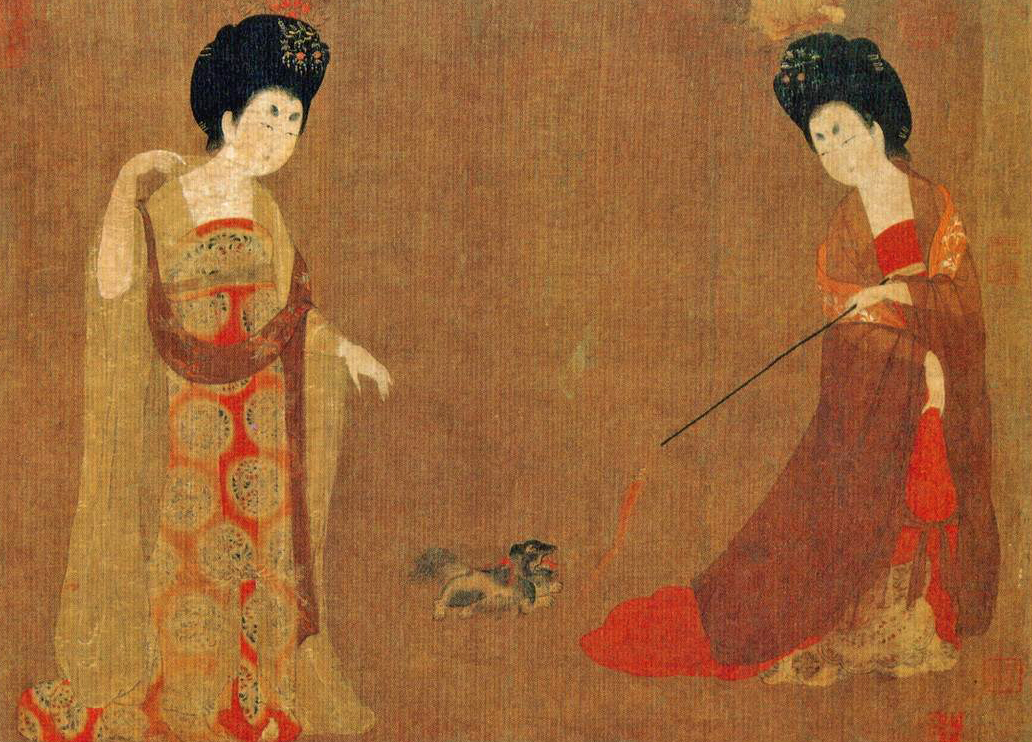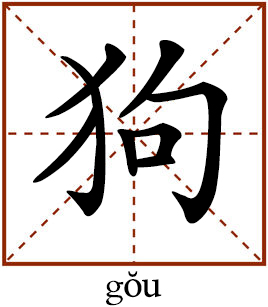The roles of dogs in Chinese culture

This picture shows part of the Portrait of a Flower-wearing Maid by Zhou Fang in Tang Dynasty (618-907), where the maids are playing with dogs.

Dogs are called gou and large ones were also called quan (犬) in the past. These two words are used interchangeably today. The word “犬” has become a component of scores of words related to animals and hunting, including wolf (狼), fox (狐狸), lion (狮), hunting (猎) and hunting in winter (狩).
The 2018 Chinese Lunar New Year—the Year of the Dog—is approaching. Dogs are called gou and large ones were also called quan in the past.
Today the terms are used interchangeably. The variant of the word quan has become a component of scores of words related to animals and hunting, including wolf, fox, lion, hunting and hunting in winter.
Dogs have been domesticated in China for more than 7,000 years and are closely related to agriculture and daily life in ancient China. There are many stories and sayings about dogs. Letters between family members are sometimes called “quan letters.” Chinese people sometimes nickname their sons “quanzi,” meaning sons of dogs, in a self-deprecating way. An idiom for helping others translates to “rendering services as a dog or a horse.”
In early Chinese history, dogs were gradually domesticated to serve two different duties. The Book of Rites said “[When sending a dog as a gift,] the dog should be held by a rope. A watch dog or a hunting dog was given to the officer who was the medium of communication; and on receiving it, he asked its name.” This indicates that dogs were domesticated for two duties—hunting and watching the houses.
Hunting dogs were usually aggressive and good at fighting. At that time, hunting dogs were primarily hounds. A story recorded in the Spring and Autumn of Lü Buwei said “A man in Qi Kingdom loved hunting. After hunting for a long time but not catching anything, he finally realized that problem lay with the hound. Too poor to afford a good hound, he went back home and worked hard in his fields. Finally, after becoming wealthy, he bought a good hound and caught many animals.” This story offers a glimpse of the important role that dogs played in society during the Zhou Dynasty.
Watchdogs also guarded the herds. Ancient Chinese noticed the vigilant and barking nature of some dogs and entrusted them with the duty of protecting homes and herds against robbers and beasts. Gradually, a belief emerged that dogs could ward off evil. Dog-shaped pottery has been found in the tombs of Han Dynasty in the Nanyang area. They were believed to protect tomb owners against evil spirits.
In addition, historical literature and ethnological studies also suggested that ancient people in frozen northern China used dogs for transportation. Even today, people of ethnic minorities in Northeast China still use dogs to pull sleds when hunting during winter.
The contributions that dogs made to human survival gave rise to dog worship in certain tribes. Legends about Panhu, a half-human and half-dog god, came into being.
Although the earliest written records about Panhu were from the third century, traces of dog worship can be found among China’s first geographic work, the Classic of Mountains and Seas. According to the book, there was a kingdom called Quanrong. They worshipped Quanrong, a god with the face of a human and body of an animal. This tale lines up with the Quanrong tribe that destroyed the Western Zhou Dynasty. The Huainanzi in Han Dynasty also mentioned a Dog State. It is a pity that these records do not give too much detail about these dog-worshipping tribes in northwestern China.
Luckily, the legends about Panhu are far more detailed in the cultures of ethnic minorities in Southwest China. Although some details are different, these legends shared a general framework. The legend goes that a western Rong tribe led an insurgency against the Emperor Ku, one of the Five Emperors in Chinese legend. A dog of Emperor Ku slipped into the military camp of the enemy and returned with the head of the enemy’s general in his mouth. Awarding his contribution, Emperor Ku married his daughter to Panhu and made him a lord. These legends are still popular among some of Chinese ethnic minorities, including She, Yao and Miao. Panhu beings are also worshipped as ancestors of the She and Yao ethnics.
(edited by CHEN ALONG)
